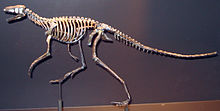This is an old revision of this page, as edited by Dinoguy2 (talk | contribs) at 16:02, 6 May 2011 (→Phylogeny). The present address (URL) is a permanent link to this revision, which may differ significantly from the current revision.
Revision as of 16:02, 6 May 2011 by Dinoguy2 (talk | contribs) (→Phylogeny)(diff) ← Previous revision | Latest revision (diff) | Newer revision → (diff)
| Ornithodirans Temporal range: Middle Triassic - Recent PreꞒ Ꞓ O S D C P T J K Pg N | |
|---|---|

| |
| Mounted skeleton of Marasuchus, an early dinosauriform | |
| Scientific classification | |
| Domain: | Eukaryota |
| Kingdom: | Animalia |
| Phylum: | Chordata |
| Clade: | Avemetatarsalia |
| Clade: | Ornithodira Gauthier, 1986 |
| Clades | |
Ornithodira is a clade within the larger group Archosauria.
In 1986 Jacques Gauthier coined the name for a node clade, containing the last common ancestor of the dinosaurs and the pterosaurs and all of its descendants. In 1991 Paul Sereno was the first to give a formal definition, that explicitly included Scleromochlus and thus potentially was a larger group than Ornithodira sensu Gauthier. In 1999 Michael Benton concluded that Scleromochlus was indeed outside of Ornithodira sensu Gauthier; that year he defined a stem clade Avemetatarsalia for all Archosauria sensu Gauthier (Benton's own Avesuchia) that were closer to dinosaurs than to Crocodylia. In 2004 Benton gave a formal definition of Ornithodira sensu Gauthier. In 2005 Sereno stated the opinion that Ornithodira was not a useful concept, whereas Avemetatarsalia was.
Members of Ornithodira are characterized by an upright gait and an S-curved neck, hence the name "Ornithodira" ("bird necks"). It is by definition strictly divided into two subclades: Dinosauromorpha and Pterosauromorpha.
Dinosauromorpha contains more basal forms like Lagerpeton and Marasuchus and more derived forms like dinosaurs, which according to most modern scientists the birds belong to as members of the theropods. The Ornithodira are therefore still extant.
Pterosauromorpha contains Pterosauria, which are the famous flying reptiles, and as far as is known the first vertebrates capable of true flight. Most researchers think pterosaurians had neither an S-curved neck, nor an upright gait: the clade Ornithodira is defined on basis of ancestry, not characters – and it is always possible later descendants show a change in characters.
Phylogeny
Cladogram after Nesbitt (2011):
| Ornithodira |
| |||||||||||||||||||||||||||||||||||||||
Further reading
- Michael J. Benton: Origin and relationships of Dinosauria. In: David B. Weishampel, Peter Dodson, Halszka Osmólska (Hrsg.): The Dinosauria. Zweite Auflage. University of California Press, Berkeley 2004, S. 7-19, ISBN 0-520-24209-2.
| Archosauromorpha | |||||||||||||||||||||||||||||||||||||||||
|---|---|---|---|---|---|---|---|---|---|---|---|---|---|---|---|---|---|---|---|---|---|---|---|---|---|---|---|---|---|---|---|---|---|---|---|---|---|---|---|---|---|
| |||||||||||||||||||||||||||||||||||||||||
| |||||||||||||||||||||||||||||||||||||||||
| |||||||||||||||||||||||||||||||||||||||||


